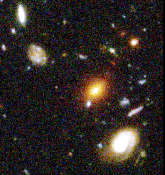The URL of this page is http://planets.utsc.utoronto.ca/~pawel/teach.html

Several hundred galaxies (some formed less than 1 Gyr after the Big
Bang) in the Hubble Deep Field project image. [Click on the fragment above
to see the whole image (0.5 MB)]. Besides the classical spiral and elliptical
shaped galaxies, there is a bewildering variety of other galaxy shapes
and colors. (courtesy: NASA). See also the Summary
Of Key Findings From The Hubble Deep Field.
UNDERGRADUATE COURSE INFORMATION
Title: Galaxies
and Galactic Dynamics (AI 1280)
Term: Fall 2002
Teacher: doc Pawel Artymowicz (tel 5537
8549; pawel@astro.su.se)
Teaching Assistant: Alexis Brandeker (tel
5537 8552; alexis@astro.su.se)
Times of lectures : 10:15 am - 12:00 am (hopefully
with a break)
Place: Stockholm Observatory SCFAB (Albanova Ctr),
6th floor, seminar room C61
Dates of lectures:
September: 25 (Wed), 30(Mo),
October: 7 (Mo), 9 (Wed)*, 16 (Wed) , 21(Mo)*,
23(Wed), 28(Mo), 30 (Wed)*,
November: 4 (Mo; rm C6:1038)
3 problem sessions: 1:15pm - 3:00pm; their dates
are denoted by * following
the lecture day
given above
Dates/times of 2 laboratory excercises: to be
arranged with the TA (teaching asst.)
Additional optional event: Cosmonova film, e.g., `Den
Oendliga Resan' (Contact udergrad. secretary).
Date of the final exam: 11 November (Mo), 10.00-12.30
and 13.30-15:30
Omtentamen (re-exam) at one date convenient for all the
interested.
Basic course reference: Binney and Tremaine, "Galactic
dynamics" (Princeton,1994)
Suggested additional reading includes at least
two of the following:
o Internet
(we recommend
www.google.com
to look for keywords; also the links below);
o Binney &
Merrifield "Galactic Astronomy", Princeton Ser. in Astroph. (1998);
o Carroll &
Ostlie "An Introduction to Modern Astrophysics" Addison-Wesley (1996)
o D. Elmegreen
"Galaxies and Galactic Structure", Prentice Hall (1998);
o Gilmore,
King & van der Kruit "The Milky Way as a galaxy", Univ. Sci. Books
(1989);
Course grading will be based on:
6 sets of homework problems, which will be handed out
(20% of the total score),
the written exam (50% for problems, 30% for test = large
set of Yes/No questions).
>75% of the max score required for VG, >50% for G grade.
Lab exercises are required to be successfully done and
described to the satisfaction of theTA, before or shortly after the final
exam.
SYLLABUS (=TOPICS)
with references to the main textbook: ch.=chapter;
ADD= handout with additional material.
Note: topic numbers do not necessarily coincide with
`lecture number'.
-
Gentle introduction to galaxies
-
Dicovery of galaxies - historical perspective
-
Stellar populations, globular and open star clusters
-
The Great Debate (1920)
-
Galaxy's kinematics, asymmetric drift diagram
Literature: ch. 1 (pages 3-29) + ADD
-
Galaxies
-
Large-scale structure of the Universe and galaxy clustering
-
Epoch of galaxy formation
-
Morfology and classification of galaxies
-
Galatic nuclei and other components
-
Comparison of the Milky Way with other galaxies
Literature: ch. 1 (pages 3-29) + ADD
-
Gravitation
-
Potentials of spherical systems
-
Potentials of axisymmetric systems
-
General methods
Literature: ch. 2 (pages 30-49, 74-80) ESPECIALLY pp. 32,
36-37, 41-43, 48, 74-80
-
Orbits
-
The Kepler problem (2-body problem)
-
Motion in spherical potential
-
Motion in axisymmetric potentials
-
Lindblad resonances in nonaxisymmetric systems
Literature: ch. 3 (pages 103-126) + ADD, ESPECIALLY pp. 103-108,
112-126, 149
-
Collisionless stellar systems
-
Fundamental equations of stellar dynamics
-
Virial equations
-
Isothermal sphere
Literature: ch. 4.1-4.3 (pages 187-231), 4.7 (pages 266-278)
ESPECIALLY pp. 190-192, 195-200, 213-214, 226-231, 269-278
-
Disk dynamics
-
Stability of disks
-
Spiral waves
-
Resonances and the global spiral structure
-
Bars and warps
Literature: ch. 6 (pages 336-413) + ADD, ESPECIALLY pp. 336-345,
355-359, 362-370, 375-405
-
Encounters and collisions
-
Observations of interacting galaxies
-
Simulations
-
Dynamical friction
-
Thickening of disks
-
Galaxy mergers vs. the virial theorem
Literature: ch. 7 + ADD, ESPECIALLY pp. 424-430, 454-469
-
Introduction to chemo-dynamics
-
Dynamical evolution in stellar systems
-
Chemical evolution
Literature: ch. 9.2 (pages 564-578) + ADD, ESPECIALLY pp.
564-577
-
Dark matter
-
Dark matter: hot vs. cold, candidate constituents
-
Dark matter: how much where
Literature: ch. 10 (pages 589-638) ESPECIALLY pp. 589-605,
614-618, 629-635
SAMPLE EXAM
Here you can see the text files with the final
exam (1999)
About the homework problems
For a guide to the style of solutions of homework (also the
exam) involving math see here.
Please remember also to: staple together your homework
or at least number the pages clearly and sign them with your name. Write
legibly: all unusually messy homeworks will be returned to you. The usually-messy
homeworks will be accepted but run the risk of being misunderstrood and/or
underappreciated. Please give enough details of the solution procedure.
It's as important as the correct final answer.
Importantly, please keep a copy of your solutions
for your use (you can use the Observatory copy machine for that). Most
solutions will be discussed during the 3 problem sessions. Finally, plan
for a timely submission of solutions. Occasional delays will be
tolerated, but very late submissions will earn very little credit.
Useful / interesting links:
-
Globular
clusters
-
Open
cluster M16
-
The
Shapley - Curtis Debate in 1920
-
On-line
Messier catalog of galaxies
-
STScI
Digital Sky Survey search form. Input ANY object's designation to get coordinates
and .GIF picture
-
Multiwavelength
Milky Way
-
The Interactive
NGC Catalog Online
-
Catalog
of galaxies (Frei & Gunn; 113 galaxies with pictures)
-
Galaxy
merger simulations, antennae galaxy pair
-
Evolution
and mergers of galaxies
-
New STScI
press releases
This way to the
home
page of Pawel Artymowicz.
